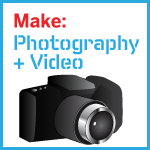Slow Motion Video from High Speed Photography
Normally, ultra slow motion video requires very expensive cameras and lots of light. Using an unconventional method reminiscent of Eadweard Muybridge’s Sallie Gardner at a Gallop, Destin from Smarter Every Day caught slow motion video of a bullet coming out of a gun. Since that particular fast action is easily repeatable, he was able to […]







